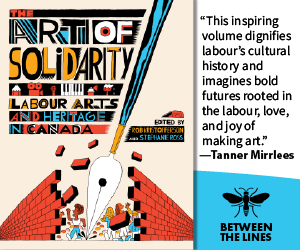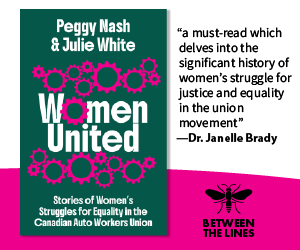A brief history of Canadian labour woes
Average hourly earnings for Canadian workers have been nearly frozen since the late 1970s

Average hourly earnings for Canadian workers have been mostly stagnant since the late-1970s, owing to the crippling of organized labour by government and capital.
Canadians are working harder but seeing slower and smaller gains.
Unifor economist Jordan Brennan, reporting for iPolitics, found that between 1977 and 2012, average hourly earnings rose three percent, despite having increased dramatically in the preceding decades.
A more recent study by James Uguccioni, Andrew Sharpe and Alexander Murray noted during roughly this same period (1976-2014), labour productivity increased by 1.12 percent per year. That’s a roughly 42 percent increase in productivity rewarded with a roughly three percent increase in earnings.
The effects are enormous. A recent headline in the Report on Business reads “Why Canadians Can’t Stop Borrowing: Stagnating Incomes.” The article suggests stagnant incomes are the core driver of Canada’s household debt crisis, as low interest rates buoy an economy lagging with no growth in the average person’s earnings. Similarly, a leaked 2014 internal government report found decades of stagnant earnings were “too weak to support [the] consumer spending that has historically driven economic growth,” resulting in middle-income Canadians being “increasingly indebted [despite] a relatively modest standard of living.”
Brennan has a theory as to why earnings are stagnant: falling union density and union power, followed by economic shifts and crises that made recovery nearly impossible.
He argues the crippling of labour left working Canadians without an avenue through which to push for increased pay or improved conditions.
Hugh Mackenzie says the connection between stronger unions and rising average earnings is fairly obvious, as “fewer avenues for wage negotiations result in stagnant wages generally.”
According to Brennan, “the secular trend in hourly earnings growth was positive and rising between 1920 and 1975… Unsurprisingly, this is also the period when unionization was expanding. Wage growth slowed abruptly in the late 1970s before plummeting in the 1980s and again in the 2000s. In this latter period, the imprint of unions on the Canadian political economy was fading.” Brennan notes from its 1975 peak of 38 percent, union density dropped to about 32 percent in 2012. This coincides with average hourly earnings mostly flattening out, after comparatively rapid increases in the decades before.
Earnings have not shot up since. In fact, median hourly earnings have remained nearly-frozen, increasing at a rate of just 0.09 percent per year until the end of 2014.
This shows that, once unions were under serious attack and density began eroding, average hourly earnings stopped increasing.
The story of how unions were weakened and density was driven down is one of the distributive struggle between labour and capital, which has shifted further in capital’s favour than at any time in nearly half a century. Ellen Russell and Mathiew Dufour argue likewise, that stagnant earnings coinciding with rising labour productivity indicates that workers’ share of growth is falling dramatically.
Appearing on the CBC, Brennan explained, “we’ve imposed decades of wage flexibility [on workers and that has] tilted the balance so far towards business that we’ve seem things stagnating for most Canadians.”
Since 1977, workers have failed to recover from a precipitous drop in gains, despite steady increases during the preceding decades of the postwar period.
This sudden drop, research suggests, was due to a direct attack on bargaining by the federal government, in league with the provinces, beginning in 1975. After that, further attacks, economic shifts and crises delayed any kind of recovery.
Brennan writes, “the optimistic assessment is that governments are attacking unions despite the fact that unions play a progressive role in middle class formation… The more cynical assessment is that government is attacking unions because they understand the role that unions play in building shared prosperity.”
To understand why wage gains dropped off after the mid-1970s, it is worth exploring the global context, as attacks on workers are very much symptomatic of the end of the “golden age,” of Canadian capitalism. In The Canadian Labour Movement (1989), Craig Heron writes:
A sense of crisis was hovering over Canadian corporate boardrooms and cabinet chambers by 1975. The anxiety was shared throughout the capitalist world. An unprecedented combination of rising unemployment and inflation was throwing the international economy into chaos. The U.S. economic empire was also in deep trouble, as upstart contenders — especially West Germany and Japan — set the new pace of capitalist growth. Ambitious developing countries such as Brazil, Taiwan and South Korea were emerging as major industrial competitors on the basis of cheap labour and repressive military regimes.
In the face of increasingly uncertain markets and stiffer competition, Canadian capitalists were beginning the desperate search for a secure place in the reconstructed world economy. Inflation and aggressive union demands, they believed, squeezed profit margins and introduced too much insecurity into capitalist planning. On that basis, Canadian capitalists pushed government to go on an offensive.
This crisis of Canadian capitalism coincided with renewed union militancy, after the Left was purged in the 1950s. During this time, Greg Albo writes, Canada lost more days to strikes than almost any other country and one third of them, in 1966, were illegal.
This militancy exploded in the 1972 Common Front strike. After 210,000 workers fought for and won a $100 weekly minimum wage, other significant pay increases and cost of living adjustments, the federal government developed plans to curb such activity and gains. The Woods Labour task force pleaded for more responsible unionism and recommended the government implement tougher legal obstacles to collective action.
In response to the stagflation crisis, mentioned by Heron, the federal government went on the offensive against labour and targeted its major gains in earnings with a demand control program. Pierre Trudeau introduced wage and price controls, weighed much more heavily against wage gains, supposedly to fight inflation. It mostly failed at the latter but, as Albo writes, it sent a clear message: “The real incomes of workers were to be kept stagnant while the profits of capital were allowed to recover.” Then-PM Trudeau referred to it as a “wrenching adjustment of our expectations.” It began at the federal level with the establishment of the anti-inflation board which, despite some reservations from the NDP, was soon applied to provincial workers. Emboldened, writes Albo, “a new toughness in management was clearly ascendant, wage gains disappeared [and] legal strikes were declared illegal.”
Craig Heron refers to this as the “state offensive,” against labour. It sparked a brief challenge through 1976, with 11.6 million days lost to strikes. According to Desmond Morton, from his 1980 volume Working People, many of these were “sacrificed to win wage gains which were just as promptly rolled back by the AIB.” Government also responded by jailing labour leaders and implementing back-to-work legislation, from 27 cases between 1965-1975, to 79 from 1975-1992.
Eventually, the resistance exhausted itself. Heron writes, “wage increases dropped off precipitously [as] workers lowered their expectations and the number of strikes plummeted. The wave of militancy had been broken.”
Though union density remained mostly unchanged for these first years of capital and government’s offensive, wage increases were almost entirely off the table due to direct coercion. With the offensive, writes Heron, “workers’ already limited room to manoeuvre within the constraints of the post-war labour legislation was reduced drastically [as] the Canadian state relied primarily on coercive mechanisms to undermine and eliminate workers’ collective power.”
The state’s offensive against labour comforted management who, emboldened, engaged in harder bargaining. This is best seen in the prelude to the 1978-1979 Inco strike where management offered a 10 percent wage increase and demanded “concessions on work rules.”
Michal Rozworski says the hard bargaining with Inco workers and the jailing of labour leaders marked “a renewed impetus on the part of business, the state and the wealthy to crackdown on labour,” like the coal miner’s strike in the United Kingdom that same year. From then on, he continues, “we’ve seen several decades of slow claw-backs and that’s true from falling wages, unionization, welfare, all with an increasing concentration of wealth and power.”
Initial militancy at the start of the 1980s, in an attempt to win back time lost to the offensive, were thwarted by an enormous recession. “In the early 1980s,” writes Heron, “the Bank of Canada used extremely high interest rates to slow down the economy, and from 1981 to 1984, the country was in the worst recession since the 1930s [as] plant-closings and layoffs of thousands of workers had devastating effects [on] working class expectations [more] profound than that of the controls program, [bosses] came to the bargaining table with newfound strength.” This saw reductions in employment which weakened unions’ ability to strike, bargain and recruit. Reigniting the labour movement became a non-starter.
The early to mid-1980s saw days lost to strikes cut by almost two thirds, as gains, especially in wages as seen in wage deceleration figures provided by Pradeep Kumar, slowed to a more significant halt by 1982 in Canada than in the United States.
Between 1981-1984, the number of locals declined also, from 15,555 in 1981 to 15,412 in 1982 to 15,187 by 1984, according to Labour Canada figures.
After the recession, faced with increased use of back-to-work legislation and harder-bargaining, labour, in its weakest position in at least a decade, took a right turn. For protection, union leadership shifted focus away from recruitment towards protecting previous victories. Labour Canada figures show the number of certifications granted drop from 3,277 in 1980 to 2,667 in 1984. They would not rise about 3,000 again. Some of this is due to increased hostility in certifying but it doubtless reflects a turn or change in approach.
“Responsible unionism created a culture of protecting existing members rather than going out and getting new ones, which makes sense if you’re under attack but it’s harmed attempts to organize the working class for greater gains,” Rozworski says.
Not only did it pose a risk to funding, but it made labour seem like a less credible force and more like a special interest group to the unorganized. Union density began declining in 1984, from 37.9 percent to 35.6 percent by 1989, while wages remained stagnant, according to Statistics Canada.
In the background, another major economic shift was beginning which would threaten the labour movement more severely than the anti-labour program of late-1970s globalization. This is a period when, as Heron writes, “capital struck back.”
In the late 1970s and early 1980s, Canadian businesses concentrated on the simple, old-fashioned method of curbing wages, but through the 1980s companies engaged in thorough economic restructuring [as] Canada’s leading corporations were preparing to be prominent contenders in world markets… Labour-intensive industries would probably not survive competition from low wage, third world produces but ‘lean’ high-tech operations might flourish, provided Canadian workers could be brought into line.
This saw production gradually shift away from Canadian cities, further compromising labour’s base.
1985-1987 were not good years for the Canadian labour movement. Union density dropped from 39 percent in 1985 to 37.6 percent by 1987. In 1987, 807 fewer certifications were granted than in 1985 after an enormous slowdown in 1986. Average real weekly earnings began to decrease during this time going from $357.01 in 1980 to $322.53 by 1988, with small fluctuations between.
Following Mulroney’s 1988 victory in the “free trade election,” union density dropped again from 37.6 percent to 36.6 percent and, soon after, Canada fell into another recession. This further undermined bargaining power.
“An awful lot of plants closed and the closures were really driven by companies that operated on both sides of the US and Canadian border consolidating their operations in either one place or the other, usually the other,” Mackenzie says. “I was involved in negotiating one plant closure involving 500 or more people every month. It was a huge haemorrhaging of established bargaining units.”
More broadly, this began the slow hemorrhaging of the Canadian labour movement’s base in private sector manufacturing. Between 1976 and 1986, union membership rates in manufacturing dropped from 43.5 to 38.3 percent. This declined further, along with union density as Canada entered the 1990s. Steve Hellinger and Karen Hansen Huhn note from 1988-1994 alone, Canada lost 17 percent of its manufacturing base. After 1994, this would accelerate.
In Hamilton and cities like it, the service sector made up 7 out of 10 remaining jobs after the slump of the early 1990s, Heron writes. Many factories closed — either they were dragged down by a sluggish economy rates, or they relocated to low-wage areas within the new free trade zone.
Subsequently, the North American Free Trade Agreement (NAFTA) weakened the bargaining floor for many workers. In the long term, NAFTA expanded the non-unionized, part-time workforce while increasing pressures for wage restraint. This gave private businesses more leverage in pushing workers for job concessions.
From 1988-1994 alone, Canada lost 17 percent of its manufacturing base. Free trade drove downsizing with outsourcing and offshoring and drove up unemployment for many.
In addition to a loss of union jobs, globalization also accelerated Canada’s shift from a manufacturing to a service sector-dominated nation, further weakening prospects for organizing. The service sector has long been known, as the “Achilles heel of the labour movement” (Yates) due to its small base and susceptibility to employer hostility. Much of this has to do with precarity, as non-standard work provides employers increased flexibility in scheduling, hiring, lay-offs and firing, acting as tools in employers’ arsenals to fight a drive. What’s more, organizing workplaces with under 40 people is very difficult, as franchises are easily shut down by employers with deep pockets. Further complicating things, low-wage workers contribute small dues, often making it a losing battle.
With labour weakened by free trade and recessions, a new attack came at the provincial level, beginning in May 1994 in Newfoundland and Labrador: card check certification. This required a secret ballot to certify a union after the initial organizing drive. This opened the door to employer intimidation. The Globe and Mail notes increasingly, “governments are backing away from legislation that had imposed first contracts in cases where organizers had been able to get 50 percent of employees to sign union cards. The new laws force the union to also clear the hurdle of a secret ballot after the original organizing drive. Labour leaders say that turns organizing into a contact sport… because it is so easy for employers to fire and blacklist anyone who gets a pro-union reputation.” A closer study by Sara Slinn notes “union avoidance activity employers engage in [is] substantially greater under a mandatory vote procedure than under card-based certification.”
This makes the primary obstacle not just layoffs, but rather the fear workers have of employer retribution against those active in a union organizing.
After much of labour’s base had been destroyed and the economy shifted to lower-paying work, the federal government’s austerity measures smashed the bargaining floor further. In 1995, the government reduced the funds available for welfare programs and eliminated most of the allocation requirements for the provinces. “At that same time that NAFTA made people more dependent on services,” says Rozworski, “cutting services makes people less willing to fight as you have less support to survive. It increases the pool of labour and drives down the standards.”
In short, average hourly earnings for Canadian workers have been nearly frozen since the late 1970s.
Wage gains were forced down by government, acting on capital’s behalf and forcing labour into harder bargaining. Instability and organizational problems rocked the movement while it was under attack, and while, in the background,— capital geared up for free trade and austerity.
As a result of these attacks on labour, workers are desperate, wages have been stagnant for nearly forty years, The Star has compared Canada’s inequality to a “1920s gilded age,” and the majority find themselves more deeply indebted than ever before.
Mitchell Thompson is a writer and heavily-indebted precarious worker in Toronto.










